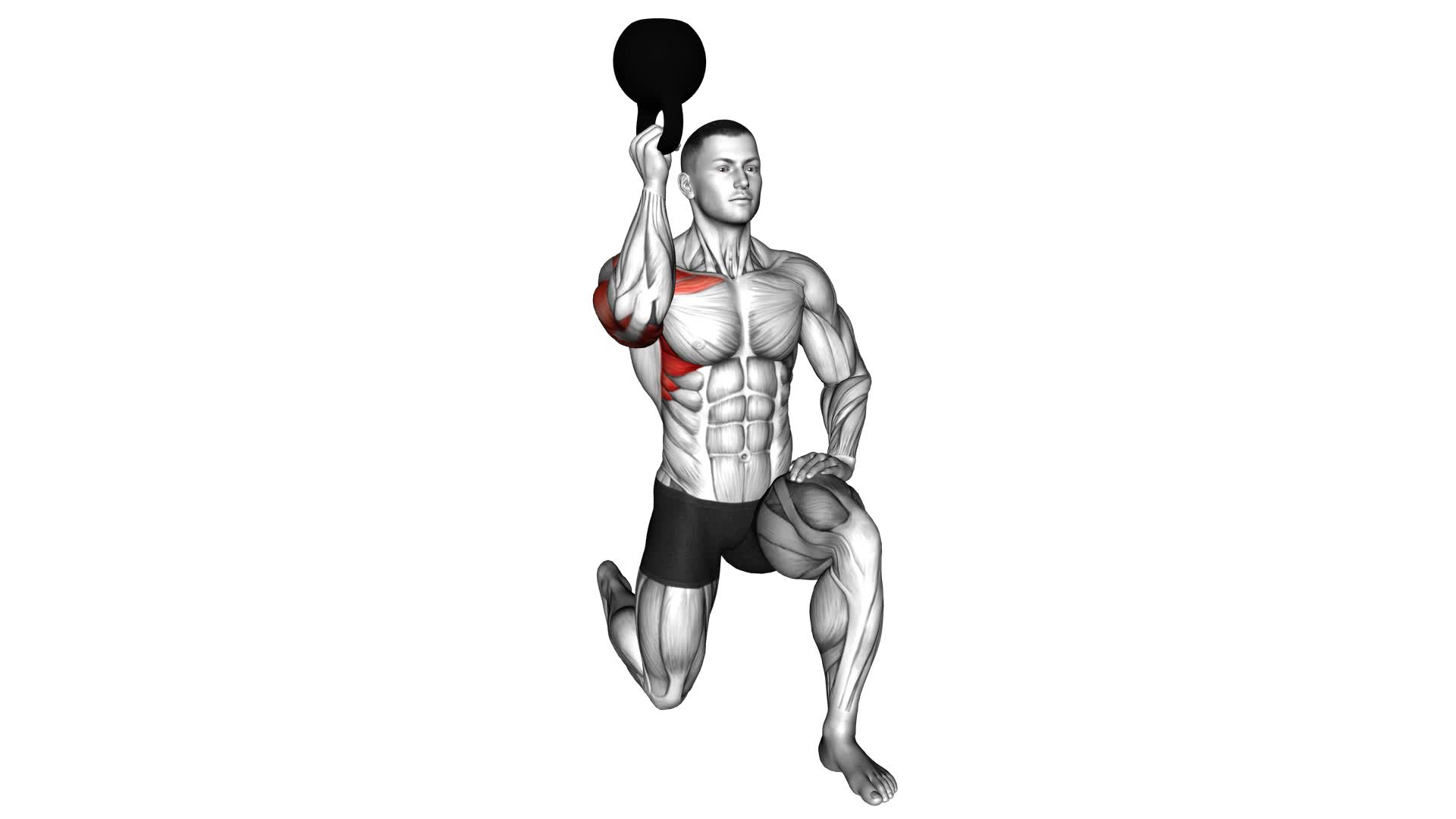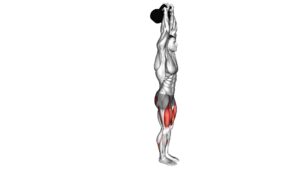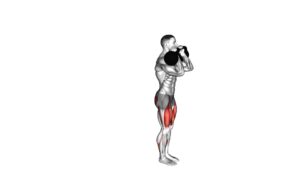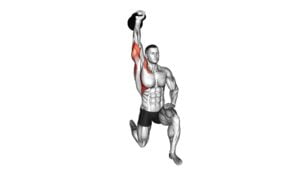Kettlebell Kneeling Shoulder Bottom-up Hold – Video Exercise Guide & Tips

Get ready to strengthen your shoulders with the Kettlebell Kneeling Shoulder Bottom-up Hold! This exercise offers numerous benefits, including improved stability and shoulder strength.
Watch This Exercise Video
In this video exercise guide, you'll learn the proper technique and form, as well as common mistakes to avoid.
With variations and progressions available, you can easily incorporate this exercise into your workout routine for maximum results.
So grab that kettlebell and let's get started!
Key Takeaways
- Kettlebell kneeling shoulder bottom-up hold enhances shoulder stability and strength.
- It targets smaller stabilizing muscles in the shoulders and activates larger muscles in the shoulder complex.
- The exercise improves grip strength and can be a valuable addition to any upper body workout routine.
- It challenges muscles to prevent plateaus and helps progress towards fitness goals.
Benefits of the Kettlebell Kneeling Shoulder Bottom-up Hold
You can experience enhanced shoulder stability and strength with the Kettlebell Kneeling Shoulder Bottom-up Hold. This exercise provides numerous benefits for your shoulder stability and muscle activation in the shoulder complex. The main benefit of this exercise is that it targets the smaller stabilizing muscles in your shoulders, which are often neglected in traditional shoulder exercises. By strengthening these muscles, you can improve your overall shoulder stability, reducing the risk of injury and improving your performance in other upper body exercises.
The Kettlebell Kneeling Shoulder Bottom-up Hold also activates the larger muscles in your shoulder complex, such as the deltoids and the rotator cuff. This helps to develop overall shoulder strength and power, which is important for activities that require upper body strength, such as lifting, pushing, and pulling.
In addition to shoulder stability and strength, this exercise also improves your grip strength. Since you have to hold the kettlebell upside down, it requires a strong grip to maintain control of the weight. This can have carryover benefits to other exercises that require grip strength, such as deadlifts and pull-ups.
Overall, the Kettlebell Kneeling Shoulder Bottom-up Hold is a highly effective exercise for enhancing shoulder stability and strength, as well as improving muscle activation in the shoulder complex. It's a valuable addition to any upper body workout routine.
Now, let's move on to the equipment and set-up for the exercise.
Equipment and Set-up for the Exercise
To properly execute the Kettlebell Kneeling Shoulder Bottom-up Hold, you'll need specific equipment and a proper set-up. The main piece of equipment required for this exercise is a kettlebell. It's important to choose a kettlebell that's appropriate for your strength and fitness level. Generally, a weight between 8 to 16 kilograms (18 to 35 pounds) is suitable for most individuals.
Additionally, you'll need a mat or a soft surface to kneel on to protect your knees from any discomfort or injury.
Before starting the exercise, it's crucial to set up the kettlebell correctly. Begin by kneeling on the mat or soft surface with your knees hip-width apart. Place the kettlebell on the ground in front of you, ensuring that it's within easy reach. To pick up the kettlebell, maintain a strong grip, engage your core, and keep your back straight. Lift the kettlebell using both hands, bringing it up to shoulder height.
In terms of the exercise set-up, find a space where you have enough room to perform the movement without any obstructions. It's also advisable to have a mirror nearby to check your form during the exercise.
Once you have gathered the necessary equipment and set up the kettlebell, you're ready to proceed with the Kettlebell Kneeling Shoulder Bottom-up Hold.
Proper Technique and Form for the Kettlebell Kneeling Shoulder Bottom-up Hold
Once you have set up the kettlebell and gathered the necessary equipment, it's important to focus on proper technique and form for the Kettlebell Kneeling Shoulder Bottom-up Hold. This exercise is great for kettlebell shoulder stability and shoulder strength training.
Here are some key points to keep in mind:
- Start by kneeling on the ground with one knee and place the kettlebell on its side in front of you.
- Grip the handle of the kettlebell with your hand and flip it upside down so that the bottom is facing up.
- Lift the kettlebell up to shoulder height, keeping your elbow tucked in and your wrist straight.
- Engage your core and squeeze your shoulder blades together to stabilize your upper body.
By following these steps, you ensure that you're performing the Kettlebell Kneeling Shoulder Bottom-up Hold with correct technique and form, which is crucial for maximizing the benefits of the exercise and preventing injuries.
Now that you understand the proper technique and form, let's move on to the next section where we'll discuss common mistakes to avoid.
Common Mistakes to Avoid
The primary error to avoid when performing the Kettlebell Kneeling Shoulder Bottom-up Hold is improper grip. To execute this exercise properly, it's crucial to have a firm and secure grip on the kettlebell. Make sure your fingers are wrapped around the handle, and your thumb is placed firmly on top. This grip will prevent the kettlebell from slipping out of your hand and causing potential injuries.
Another common mistake to avoid is improper positioning of the shoulder. When performing the Kettlebell Kneeling Shoulder Bottom-up Hold, it's important to keep your shoulder stable and engaged. Avoid shrugging your shoulder or letting it collapse. Instead, focus on maintaining a strong and stable position throughout the exercise.
Furthermore, it's essential to avoid using excessive weight. Starting with a lighter kettlebell allows you to focus on proper technique and form. Gradually increase the weight as you become more comfortable and confident with the exercise.
Lastly, avoid rushing through the movement. The Kettlebell Kneeling Shoulder Bottom-up Hold requires control and stability. Take your time to engage the correct muscles and maintain proper form throughout each repetition.
Variations and Progressions for the Exercise
Continue building upon your progress by exploring various variations and progressions for the Kettlebell Kneeling Shoulder Bottom-up Hold exercise. These variations and progressions won't only challenge your muscles in different ways but also help you improve your overall strength and stability.
Here are four options to consider:
- Single-arm Kneeling Shoulder Press: Instead of holding a kettlebell with both hands, perform the exercise with just one arm. This will increase the demand on your core and shoulder muscles, as they've to work harder to stabilize your body.
- Alternating Kettlebell Kneeling Shoulder Press: Start with a kettlebell in each hand and alternate pressing one arm at a time. This variation adds an element of coordination and balance to the exercise, while also providing a greater challenge to your shoulder muscles.
- Kneeling Bottom-up Hold with Overhead Reach: Hold the kettlebell in the bottom-up position and, instead of pressing it overhead, reach your arm straight up towards the ceiling. This variation targets your shoulder stability and mobility, as well as your core muscles.
- Kneeling Bottom-up Hold with Rotation: In this variation, hold the kettlebell in the bottom-up position and rotate your torso from side to side. This challenges your core muscles and improves your rotational stability.
By incorporating these variations and progressions into your routine, you can continue to challenge your muscles, prevent plateaus, and make progress towards your fitness goals.
Now, let's move on to some tips for incorporating the kettlebell kneeling shoulder bottom-up hold into your workout routine.
Tips for Incorporating the Kettlebell Kneeling Shoulder Bottom-Up Hold Into Your Workout Routine
To effectively incorporate the Kettlebell Kneeling Shoulder Bottom-Up Hold into your workout routine, start by selecting an appropriate weight. The weight should challenge you without compromising your form and technique. You can gradually increase the weight as you build strength and stability in your shoulders.
When incorporating kettlebells into your shoulder stability exercises, it's important to prioritize proper form and technique. Start by kneeling on the ground with one knee and place the kettlebell upside down on your shoulder. Grip the handle firmly, keeping your wrist straight. Engage your core and squeeze your glutes to maintain a stable position.
Hold the kettlebell in the bottom-up position for a specified amount of time, typically between 20-30 seconds. Focus on maintaining a stable shoulder position throughout the exercise. Avoid shrugging your shoulders or allowing them to collapse.
To maximize the benefits of the Kettlebell Kneeling Shoulder Bottom-Up Hold, incorporate it into your workout routine 2-3 times per week. Start with 2-3 sets of 20-30 seconds and gradually increase the duration or number of sets as you progress.
Remember to listen to your body and adjust the weight and intensity accordingly. If you experience any discomfort or pain, stop the exercise and consult with a qualified fitness professional.
Frequently Asked Questions
Can the Kettlebell Kneeling Shoulder Bottom-Up Hold Be Performed Without a Kettlebell?
Yes, you can perform the kettlebell kneeling shoulder bottom-up hold without a kettlebell. There are alternative equipment options you can use, such as a dumbbell or a weighted ball, to achieve a similar exercise.
For beginners, modifications can be made by using lighter weights or starting with a kneeling position and gradually progressing to a standing position. These modifications help build strength and stability before attempting the full exercise.
How Many Sets and Reps Should I Do for the Kettlebell Kneeling Shoulder Bottom-Up Hold?
For the kettlebell kneeling shoulder bottom-up hold, it's important to start with an optimal weight that challenges you but still allows for proper form. Gradually increase the weight as you get stronger. Aim for 3-4 sets of 8-12 reps.
Be sure to avoid common mistakes such as rounding your shoulders or arching your back. Focus on stability and control throughout the exercise.
Can I Perform the Exercise if I Have a Shoulder Injury?
If you have a shoulder injury, it's important to modify your exercises to avoid further damage. The Kettlebell Kneeling Shoulder Bottom-up Hold may not be suitable for you in this case.
However, there are alternative exercises that can help strengthen your shoulders without exacerbating your injury. Consult with a qualified fitness professional who can guide you through appropriate modifications and suggest alternative exercises that will be safe and effective for you.
What Muscles Does the Kettlebell Kneeling Shoulder Bottom-Up Hold Target?
The kettlebell kneeling shoulder bottom-up hold primarily targets the shoulder muscles, specifically the deltoids, rotator cuff muscles, and the trapezius. This exercise also engages the muscles in your core, including the abdominals and obliques, as well as the muscles in your upper back and arms.
Variations of the kettlebell kneeling shoulder bottom-up hold can further target the biceps and improve grip strength. Incorporating this exercise into your routine can help build upper body strength and stability.
How Long Should I Hold the Kettlebell in the Bottom-Up Position During the Exercise?
When performing the bottom-up kettlebell hold, it's important to focus on shoulder stability. This exercise challenges your muscles to maintain control as you hold the kettlebell upside down.
The length of time you should hold the kettlebell in this position depends on your strength and comfort level. Start with shorter holds and gradually increase the duration as you build strength.
The benefits of bottom-up kettlebell holds include improved grip strength, shoulder stability, and overall upper body strength.
Conclusion
In conclusion, the kettlebell kneeling shoulder bottom-up hold is a challenging exercise that offers numerous benefits for shoulder stability and strength. By properly engaging the core and maintaining proper form, this exercise can help improve overall shoulder function and prevent injuries.
Remember to start with a lighter weight and gradually increase as your strength and stability improve. Incorporating this exercise into your workout routine can be a great way to enhance your shoulder strength and stability.

Author
Years ago, the spark of my life’s passion ignited in my mind the moment I stepped into the local gym for the first time. The inaugural bead of perspiration, the initial endeavor, the very first surge of endorphins, and a sense of pride that washed over me post-workout marked the beginning of my deep-seated interest in strength sports, fitness, and sports nutrition. This very curiosity blossomed rapidly into a profound fascination, propelling me to earn a Master’s degree in Physical Education from the Academy of Physical Education in Krakow, followed by a Sports Manager diploma from the Jagiellonian University. My journey of growth led me to gain more specialized qualifications, such as being a certified personal trainer with a focus on sports dietetics, a lifeguard, and an instructor for wellness and corrective gymnastics. Theoretical knowledge paired seamlessly with practical experience, reinforcing my belief that the transformation of individuals under my guidance was also a reflection of my personal growth. This belief holds true even today. Each day, I strive to push the boundaries and explore new realms. These realms gently elevate me to greater heights. The unique combination of passion for my field and the continuous quest for growth fuels my drive to break new ground.







